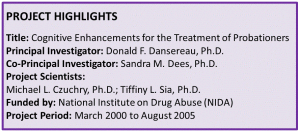Cognitive Enhancements for the Treatment Of Probationers

Building on research findings from Phase 1, the primary objective of the 5-year CETOP Phase 2 Project was to assess the impact of introducing into a criminal justice substance abuse treatment program cognitive activities specifically designed to (a) increase probationers’ motivation for treatment and (b) promote development of skills that can be useful during treatment. Since probationers frequently come to a criminal justice treatment program with little motivation and no concept of what to do to benefit from treatment, this second project phase employed and extended the motivational and skill-based elements found to be effective with this population. A second major objective was to determine how these activities can be most effectively combined and efficiently delivered.
On-site implementation was relocated to the Dallas County Judicial Treatment Center (under the administration of Cornell Companies, Inc.) in Wilmer, Texas, when the Tarrant County Substance Abuse Treatment Facility site was changed to an outpatient program. The Wilmer facility provided 6 months of residential treatment to approximately 450 probationers each year. Three major studies were conducted to assess the effects of the Motivation Module (Study 1), the Skills Module (Study 2), and the combination of Motivation and Skills Modules (Study 3). In all three studies, residents were randomly assigned to receive enhancements or treatment as usual (TAU).
The broad research questions addressed by each study were:
- What are the during-treatment effects of these modules on indicators of motivation and on responses to critical aspects of the treatment program and on perceptions of personal change during treatment? Questionnaires were administered at the beginning, middle, and end of treatment.
- Who benefits the most? Answers to this question help determine how to tailor treatment to meet the needs of specific individuals.
The MOTIVATION Module: the “TCU Personal Power Series”
Under Construction. This was a three-part activity that included the Tower of Strengths (a card sorting task in which individuals select strengths they have and strengths they desired), the Building Blocks (selection and generation of quotes that will help individuals attain desired strengths), and a Putting Together Map (where clients see how to apply strengths and quotes to a personal problem). This activity had been shown to improve motivation and therapeutic outcomes in treatment, and helped calibrate self-esteem (too low or too high levels of self esteem have both been found to be problematic in treatment).
Downward Spiral. Five to six participants took the roles of people who are committed to a life of substance abuse. In this board game, the “winner” was the player who stays alive and loses the least of the allotted life resources (e.g., health, family, friends). Players “moved” by drawing cards to read about real situations; they suffer consequences of continued substance abuse by losing “life points” (Czuchry, Sia, & Dansereau, 1999; Czuchry, Sia, Dansereau, & Dees, 1997).
Personal Power Manuals and RAFTing. Participants read and completed 4 workbooks, both in session and as homework. They learned a Relax And Focus Technique (RAFTing) that can be used regularly as a self-modulation and control strategy.
RAFTing and Mind Play. This is an audio CD that guides clients through relaxation and visualization techniques that have been shown to be effective in substance abuse treatment. Research has shown that it facilitates therapeutic improvement in treatment for probationers.
The COGNITIVE SKILLS Module
The Thought Team. Participants are taught to visualize a “team” of people who can give them quality input on personal decisions and plans (i.e., perspective taking). They then used this team as they create written solutions to sets of “tough situation” scenarios. These were real-life situations which they may themselves encounter (Weldon & Dansereau, 1999).
Map Magic (Mapping). Participants were taught to organize their thoughts into graphic node-link representations using either free form or “guide” maps (a fill-in-the node structure; Czuchry & Dansereau, 1999; Newbern, Dansereau, & Dees, 1997; Newbern, Dansereau, & Pitre, 1997; Pitre, Dansereau, Newbern, & Simpson, 1998; Pitre, Dees, Dansereau, & Simpson, 1997). This was a manual-driven activity followed by a scripted peer cooperative problem-solving activity.
View Point Game. This activity involved playing a perspective shifting game that taught individuals a difficult cognitive skill in an engaging, social format. Players applied quotes, symbols, people, and personal strengths to personal problems in an effort to develop workable solutions. The View Point Game had been shown to increase creative problem solving in college students.
Findings
Research from the second phase of CETOP demonstrated that these motivation modules:
- increase motivation to resist drug use and to avoid unsafe sexual practices (Czuchry & Dansereau, 2005),
- help sustain motivation over time and improve perceptions of the counselors and counseling sessions (Czuchry, Sia, & Dansereau, 2006),
- and are especially beneficial for:
– females (Czuchry, Sia, & Dansereau, 2006)
– clients who are impulsive (i.e., have low need for cognition; Czuchry &
Dansereau, 2004).

Introduction Guide for Mapping-Enhanced Counseling available
from the IBR Website
Mapping-Enhanced Counseling: An Introduction provides an overview with case examples of ways to incorporate mapping-enhanced counseling into your practice.
Sections include:
- Introduction: TCU Mapping-Enhanced Counseling — Introduction and overview to working with TCU Mapping-Enhanced Counseling.
- Part 1: Overview of Mapping-Enhanced Counseling Strategies — Background and primer for using node-link mapping for individual and group work.
- Part 2: The Mapper’s Dozen — Twelve multipurpose guide map templates with examples of customization to tailor maps to treatment needs.
- Part 3: Case Studies with Maps — Ideas for using maps to work with clients around issues identified as part of treatment planning.
- Appendix: Bibliography — Bibliography of mapping research studies.